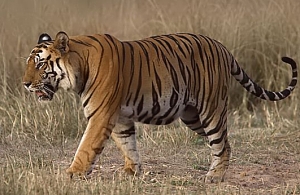 |
| An Asiatic lion pair in Gir Forest National Park |
 |
| View of Kuno-Palpur Wildlife Sanctuary |
It looks this ongoing debate between the governments of Gujarat and Madhya Pradesh about the reintroduction of the Asiatic lion has come to a halt. For nearly twenty years, the two governments had been constantly arguing of translocating lions from Gir Forest to the forests of Kuno-Palpur Wildlife Sanctuary in Madhya Pradesh. Much of the arguments given by each side were largely political with the Madhya Pradesh government arguing that Gujarat's lion population has increased to such an extent that the animals should be transferred to Madhya Pradesh so that the state could start its own lion population. The government of Gujarat, on the other hand, was reluctant to do such a thing arguing that the lions are the "state's heritage" and that the poachers targeting them in Gir Forest come from Madhya Pradesh. Eventually, the Madhya Pradesh government gave up hope and has now decided to release tigers into Kuno-Palpur Wildlife Sanctuary.
 |
| The government of Madhya Pradesh is now focusing on releasing tigers into Kuno-Palpur Wildlife Sanctuary |
I find this news very interesting because it marks the end of the 20-year debate between Gujarat and Madhya Pradesh over the translocation of lions outside Gujarat. However, it also implies that the efforts Gujarat government put in challenging the Supreme Court's order in 2013 about lion translocation in Madhya Pradesh have paid off. Two years ago, the government of Gujarat presented an argument to the Supreme Court based on studies and guidelines of the International Union of Conservation of Nature (IUCN), a petition filed by the Wildlife Conservation Trust, Rajkot, and a report by the National Tiger Conservation Authority (NTCA). The argument stressed that reintroducing lions in Kuno-Palpur Wildlife Sanctuary may prove to be harmful for lions, the wildlife sanctuary is an important corridor for tiger movement between Ranthambore National Park and Sehore district, and that the lions are not in any threat of extinction for the next hundred years. Before presenting such an argument, Gujarat government was mainly stressing about the lion being the state's heritage. This showed that the collaboration between conservation groups and governments can make a difference in issues related to wildlife and conservation. The government of Madhya Pradesh now wants to release tigers into Kuno-Palpur Wildlife Sanctuary, but it has not notified that the sanctuary's buffer zone is a protected area which the Gujarat government has argued. It is highly essential that the Madhya Pradesh government announce the sanctuary's buffer zone as a protected area before releasing tigers into Kuno-Palpur. At the same time, the government should collaborate with conservation groups to ensure the animals' safety and well-being.
View article here
No comments:
Post a Comment